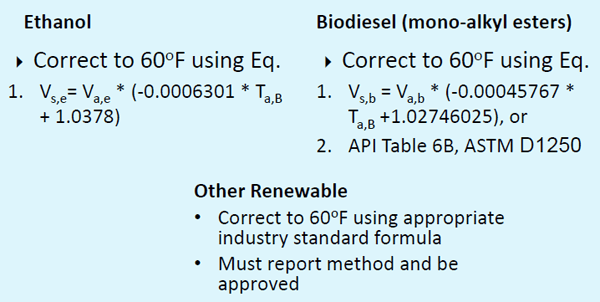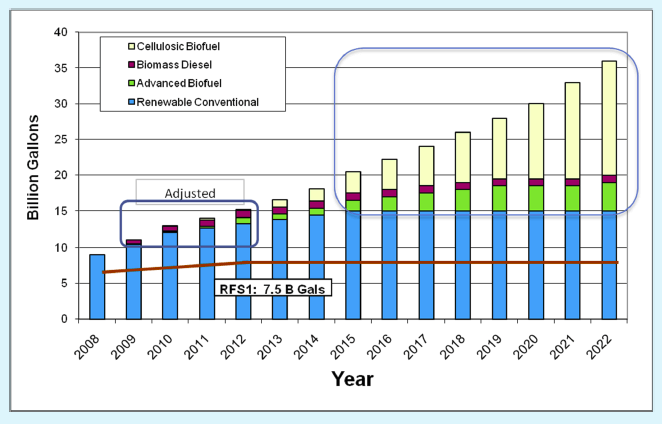Federal, state, and local regulations keep changing and impact process manufacturers’ operations. Emerson’s Patrick Truesdale provided an update on the US Renewable Fuel Standard (RFS) at a past American Fuel & Petrochemical Manufacturers conference (formerly National Petrochemical & Refiners Association, NPRA).
Here is the history of the RFS from the U.S. Environmental Protection Agency website:
Patrick opened by showing a graph of the size of the challenge to refiners. Some practical aspects of the challenge include the specification standards and associated regional and seasonal blend requirements, the blend wall, measurement accuracy, market conditions and the associated economic drivers, and Renewable Identification Number (RIN).The RFS program was created under the Energy Policy Act (EPAct) of 2005, and established the first renewable fuel volume mandate in the United States. As required under EPAct, the original RFS program (RFS1) required 7.5 billion gallons of renewable- fuel to be blended into gasoline by 2012.
Under the Energy Independence and Security Act (EISA) of 2007, the RFS program was expanded in several key ways:
- EISA expanded the RFS program to include diesel, in addition to gasoline;
- EISA increased the volume of renewable fuel required to be blended into transportation fuel from 9 billion gallons in 2008 to 36 billion gallons by 2022;
- EISA established new categories of renewable fuel, and set separate volume requirements for each one.
- EISA required EPA to apply lifecycle greenhouse gas performance threshold standards to ensure that each category of renewable fuel emits fewer greenhouse gases than the petroleum fuel it replaces.
RFS2 lays the foundation for achieving significant reductions of greenhouse gas emissions from the use of renewable fuels, for reducing imported petroleum, and encouraging the development and expansion of our nation’s renewable fuels sector.
The blend wall refers to the fact that the amount of ethanol that can be blended into gasoline is limited by the overall demand for gasoline as well as the blend formulations. E10 refers to a 10% ethanol blend and is common in the U.S. There is contention on whether car engines, without modification, will run on higher ethanol blends without damage over time.
Patrick highlighted the challenge in measurement accuracy as measuring between a rock and a hard place. Two U.S. federal regulations—the Alcohol, Tobacco Products and Firearms’ 27CFR 19.1005 and the Internal Revenue Service’s Pub L. 110-234 provides an alcohol denaturant accuracy of 0.04% between 1.96% and 2.0%.
Biodiesel has its own measurement challenges including cold flow properties, fuel stability over time, and limited standards for volume corrections. He shared volume standardization formulas for ethanol and biodiesel. Since these fuels are sold to consumers, each state has laws for composition accuracy.
 Patrick shared how technology could help address some of these challenges. For blending of alternative fuels with gasoline, mass flow meters can help. As we highlighted in an earlier post, tank monitoring for inventory levels and overspill protection can optimize operations.
Patrick shared how technology could help address some of these challenges. For blending of alternative fuels with gasoline, mass flow meters can help. As we highlighted in an earlier post, tank monitoring for inventory levels and overspill protection can optimize operations.
Precise custody transfer plays an important role for inventory tracking, reporting, and loss control. And, as we highlighted in earlier posts, monitoring not just the critical assets such as turbines, but also the essential assets, can head off unplanned downtime and quality excursions.
Additional regulations place cost burdens on refiners, but Patrick notes that there are incentives to optimize blending and logistics operations in conjunction with a focused terminal management and automation system. These include:
- Improve asset utilization
- Reduce quality giveaways
- Minimize offspec blends – reblends, touchups, downgrades
- Balance component stocks – e.g. long or short positions
- Minimize demurrage, missing pipeline window
- Optimize blends – component costs, additive, & Renewable Identification Number System (RIN)
- Track results – qualities, quantities, recipe, RIN
- Adapt to new components, new specifications
- Manage inventories – days forward supply
- Reduce hydrocarbon losses
- Comply with EPA and IRS regulations
- Improve customer goodwill (lost sales/opportunities)





